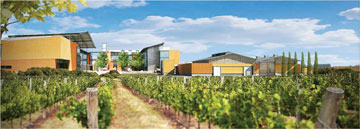Volume 27 · Number 1 · Fall 2009
Giving
Building support for a sustainable future

Architectsí rendering of the teaching and research winery (directly above, to the right of the current Robert Mondavi Institute for Wine and Food Science)
When Jess Jackson, founder of Kendall-Jackson wines, and his wife, Barbara Banke, made a gift to the new teaching and research winery at UC Davis, they weren’t simply supporting construction of a new building. They wanted to help ensure that the facility, which will be part of the Robert Mondavi Institute for Wine and Food Science, would meet top standards of eco-friendly construction and design.
Philanthropic gifts increasingly help the campus achieve its sustainability goals and often mirror a donor’s own commitment to environmental stewardship. For the past 30 years, Jackson and Banke have incorporated sustainable methods of grape growing and wine making in the Jackson Family Wines, and their recent gift reflects that dedication.
“Jess and I are excited that UC Davis will be taking the leadership role in sustainable viticulture and winemaking,” Banke said. “It is essential for all of us to be good stewards of the land and leave it better than we found it.”
The teaching and research winery (yet to be named) and the August A. Busch III Brewing and Food Science Laboratory, also part of the Robert Mondavi Institute (RMI), are being constructed entirely with private funds, led by the late winemaker Robert Mondavi. A second group of winery partners, led by Kendall-Jackson, J. Lohr Vineyards & Wines and the Wine Group, provided the extra funding to construct the winery and lab to standards of Leadership in Energy and Environmental Design (LEED) Platinum Certification — the highest rating awarded by the U.S. Green Building Council, which would make it the only winery facility at this LEED level in the world.
The winery is intended to be the first in the world that is fully solar-powered at peak load, equipped to capture and sequester all carbon dioxide from its fermentations and operated on captured rainwater for its cleaning needs.
“By building to this level of LEED certification, UC Davis will serve as a model for what the wine, brewing and food industries can achieve in environmental and energy efficiency, and educate the world’s future vintners about best practices in the industry,” said Jerry Lohr, president of J. Lohr Vineyards & Wines, who has given generously to various areas of the RMI. “I’m hopeful that gifts like this will encourage others to give as well.”
Aggie Connections
A student talks about why she makes calls for the Annual Fund, and an alumnus, why he answers. More . . .
In fact, private gifts to the university have ensured that several new facilities excel in energy and environmental design, conserving resources for the long run. Charitable gifts from many donors placed the UC Davis Tahoe Environmental Research Center among one of only five science laboratories in the world to receive a Platinum LEED Certification.
Maurice J. Gallagher, Jr. Hall, the Graduate School of Management’s new home scheduled to open this fall, will be one of the most technologically advanced buildings at UC Davis, with a cutting-edge underground heating and cooling system. The building, named in honor of the Las Vegas airline executive, was made possible in part by a generous gift from Gallagher ’71 and his wife, Marcia, the largest from an alumnus to the university.
Clayton Halliday, assistant vice chancellor and campus architect, expects the building to meet the Gold standard of LEED certification, which would make it among the “greenest” buildings in the UC system.
Gladys Valley Hall, named after the late Gladys Valley, whose family foundation — the Wayne and Gladys Valley Foundation — has provided major philanthropic support to the School of Veterinary Medicine, is currently undergoing certification process to achieve LEED Silver Certification. The School of Law’s King Hall expansion is expected to meet LEED Silver level as well.
“Philanthropic gifts help us design and construct high-performance facilities for our faculty, students, and staff,” Halliday said. “Using the most appropriate green building technologies, we design for the long term, to do our part for a sustainable future.”
